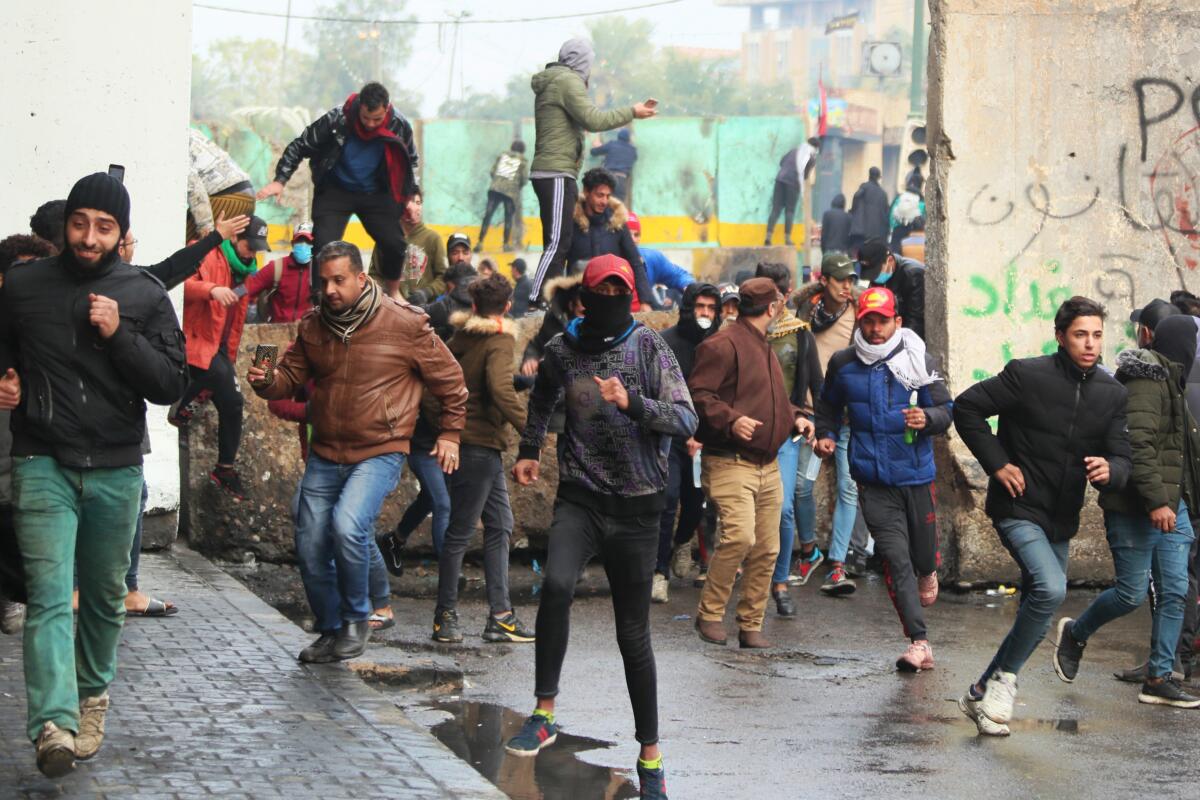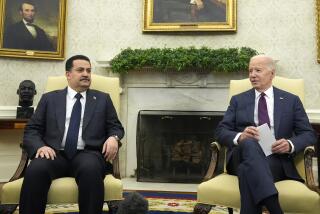Op-Ed: Iraq and the U.S., after years of conflict, still need each other

- Share via
After months of being run by a caretaker government, Iraq’s Parliament has finally approved a new prime minister, the former intelligence chief Mustafa Kadhimi. To succeed, Kadhimi will need to make progress on two policy fronts: finding a way, with Washington, to sustain the U.S. military partnership, and developing a plan for economic reform and renewal.
Iraq’s problems are even more daunting now than they have been in recent years. After the U.S killing in January of Qassam Suleimani, the Iranian military mastermind, as well as an Iraqi militia leader, Iraq’s parliament approved a nonbinding resolution that American forces should leave the country. After rocket attacks on March 11 killed two Americans and a British soldier, the U.S. retaliated against the suspected perpetrator, an Iran-backed militia.
American forces are taking precautions and consolidating positions in fewer, better-protected bases, but the situation remains highly fraught. It is not clear if the government, as opposed to the parliament, will now support the American military presence.
There is little doubt that Iraqis and Americans are better off working together, especially now.
For Iraqis, the American presence is an important counterweight to Iran and Islamic State. Americans are also helpful with Iraqi internal politics, especially with sectarian divisions in the security forces, often defusing tensions and mistrust between them. That was true during the surge of 2007-08. With Islamic State stepping up attacks during the COVID-19 lockdown, this concern is again acute.
For the United States, there are also important reasons to sustain a close partnership. That became crystal clear in 2014, when President Obama, after having celebrated the withdrawal of all U.S. troops from Iraq in 2011, had to send them back to contend with Islamic State. Otherwise, even larger refugee flows into Europe and beyond would have resulted, and major centers of oil production near the Persian Gulf could have been threatened.
Islamic State and other terrorist groups remain a threat today, even if they no longer hold territory in Iraq. They are deploying new tactics of small-scale, hit and run operations that take advantage of the gaps in security that have resulted from redeployments of Iraqi soldiers and police to ensure compliance with coronavirus lockdown restrictions. Today, the role of U.S. forces is mostly to support Iraqi soldiers and police with training and technical assistance rather than combat-related operations.
Sustaining American support in Iraq will require greater clarity between Baghdad and Washington on rules of engagement. Iraq needs to do much more to help protect American bases and other interests in the country. The United States needs to limit any unilateral use of military force against those who may have fired upon its forces. Any retaliatory actions, however justifiable, should be undertaken only after consultation and agreement between the two governments.
The new Iraqi government also needs a strategy for weakening and eliminating the Iran-backed and other private militias. They helped with the defeat of Islamic State, but are also destabilizing forces. Militia fighters or small units capable of combat could be recruited into the armed security services. Others should be offered compensation and job opportunities. The ability to make progress on this front will be an important indicator of whether the new Iraqi prime minister can stabilize the country in a way most of his predecessors could not.
On the economic front, frustrations with corruption and lack of opportunity had already produced mass demonstrations in 2019 unlike any seen in recent decades. That was before COVID-19 and the associated drop in oil prices.
It will take time to recover from the current crisis, not to mention decades of corruption and misrule by Iraqi elites. But Kadhimi can buy time, and support, by persuading the Parliament to pass petroleum revenue-sharing laws that allocate funds consistently and equitably across the entire country, with revenues distributed on the basis of provincial population.
High unemployment is also a major problem, a key cause of many demonstrations throughout Iraq. If done fairly, privatization of state-owned entities could help. A legacy of state dominance of the economy continues to stymie economic growth and job creation.
Protesters have also demanded early parliamentary elections, which the government should schedule within a year. Before the vote, it needs to replace the electoral commission and its sectarian quota system with an electoral commission largely composed of independent judges.
Many of these changes could benefit from American technical assistance and aid. But none will require significant new resources. After years of conflict and acrimony, the two countries still need each other. It may yet be possible to turn the corner and enter a more productive relationship. Let’s hope Baghdad and Washington can seize the moment.
Sara Allawi is the head of the youth movement of the Iraqi National Party. Michael O’Hanlon is a senior fellow at the Brookings Institution.
More to Read
A cure for the common opinion
Get thought-provoking perspectives with our weekly newsletter.
You may occasionally receive promotional content from the Los Angeles Times.










